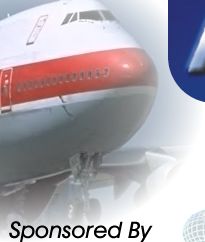















 |
 |
||||||||||||||||||
 |
|||||||||||||||||||
 |
|||||||||||||||||||
 |
|||||||||||||||||||
 |
|||||||||||||||||||
 |
 |
||||||||||||||||||
 |
|||||||||||||||||||
 |
|||||||||||||||||||
 |
|||||||||||||||||||
 |
|||||||||||||||||||
 |
|||||||||||||||||||
 |
|||||||||||||||||||
 |
|||||||||||||||||||
 |
|||||||||||||||||||
Global air traffic movements have, since the early 1980s, increased at 5.5% per annum and are forecast to continue to do so well into the new millennium (Source: ICAO Circular 270-AT/111, Outlook for Air Transport To the Year 2005). Industry studies have demonstrated that the existing Air Traffic Control (ATC) infrastructure will not be able to cope with the forecast levels of air traffic - resulting in an "ATC Gridlock" and decreased levels of safety. The ATC system must change, and the availability of reliable air/ground datalinks integrating ATC systems with aircraft systems is a fundamental element of this change.
Under the auspices of the International Civil Aviation Organisation (ICAO), the world's Air Traffic Service providers, IATA and the industry have defined a global standard (ICAO Doc. 9705-AN/956 - Manual of Technical Provisions for the ATN, 2nd Edition 1999 and ICAO Doc. 9694-AN/955 - Manual of Air Traffic Service Datalink Applications, 1st Edition 1999) that will integrate air/ground and ground/ground datalinks to provide the aeronautical community with a standardised seamless data communications service for Air Traffic Service datalink services. This standard is known as the Aeronautical Telecommunication Network (ATN).
The high level Standards and Recommended Practices (SARPs) for the ATN are included in the ICAO Annex 10, Volume III, Part 1, Chapter 3 (Aeronautical Telecommunication Network), introduced as part of Amendment 73 to Annex 10, applicable with effect from November 1998.
The initial Air Traffic Services (ATS) to be offered by the ATN, i.e. Controller Pilot Data Link (CPDLC) and Automatic Dependant Surveillance (ADS) will relieve R/T congestion and provide accurate and timely surveillance information in remote and oceanic regions. The result of these services will reduce controller workload and correspondingly increase capacity and safety levels.
The ATN will also provide air/ground data communications services for airline company communications, i.e. Aeronautical Operational Control (AOC). As the existing Aircraft Communications and Reporting System (ACARS) reaches saturation the airline community is looking to migrate existing ACARS and new applications over the ATN.
The ATN is a global ICAO standard. It will potentially need to be implemented by every ICAO State and aircraft operating in these States. The EUROCONTROL Petal II trial is currently evaluating and validating operational services and procedures with participating operational ATC centres and commercial airlines. The initial implementation of the ATN in the US is expected to be operational at Miami ACC in 2002/3 and across the entire en-route US airspace shortly afterwards. Main European States are expected to introduce initial ATN services from 2005 onwards. ATN implementation plans covering all regions of the globe are under development.
In the interim, in some regions of the world (e.g. ASIA/PAC) a number of States and Airlines have implemented the FANS 1/A system for initial ATS datalink services based on CPDLC and ADS. Whilst the FANS 1/A system is now providing ATS benefits it is generally accepted that the "end-state" infrastructure should be based on the internationally standardised ATN. The community faces a challenge of allowing FANS 1/A and ATN technologies to co-exist and then to agree and implement a transition plan that will result in the replacement of the FANS 1/A system with ATN. Furthermore, many regions of the world, where there is no existing data link infrastructure, are considering the benefits of initial FANS 1/A implementation versus direct implementation of the ATN. ATN2000 will provide delegates with key information to take into account when making such significant infrastructure investment decisions as well as presenting the lessons learnt of existing FANS 1/A and ATN based programmes.
The cost benefit studies for ATS Data Link in Europe have shown that a minimum level of 50% aircraft equipage is needed before there is a financial benefit to CAAs and the airline industry. But, from then on the accumulative savings are considerable, as are the operational benefits. Bearing this in mind, the airlines represented on the IATA Data Link Facilitation Task Force (DLFTF) have agreed a position statement on the desirability of Mandating ATS Data Link Equipage. They have recognised that, in the fragmented European Airspace, it is necessary for the ATS providers and airlines to invest together according to an agreed timetable and as an industry rather than as a series of separate investment decisions. Otherwise investment in ATS Data Link may be wasted or not happen at all.
IATA will present the case for mandating ATS Data Link equipage and this will be followed by a panel discussion and debate chaired by Derek McLauchlan (CANSO). This will be your chance to make your views known and hear those of others on an issue that may well be one of the most significant procurement issues facing your organisation in the coming decade.
One of the key elements of "transition" is the way in which both FANS 1/A and ATN architectures can be accommodated. AIRSYS ATM will conduct a demonstration of dual stack ATN, FANS 1/A ground systems (including HMI) connected to a simulated aircraft.
Following the success of the ATN'99 conference, ATN2000 has been produced with the objective of sharing and disseminating management, operational, technical and economic experiences acquired by the organisations currently leading the implementation of ATN within the global aviation community. ATN will have major impacts for the Air Traffic Service providers, Airlines, aircraft manufacturers, and the aviation industry in general.
ATN2000 is the industry event focused on ATS data link implementation. ATN2000 provides an unparalled opportunity to gain from the experiences of the States, airlines and industry at the forefront of ATN and FANS 1/A implementation. Can you afford to miss it? ATN2000 provides an invaluable opportunity not only to hear first-hand how ATS data link will reshape Air Traffic Management Systems of the future, but also to question the conference speakers and to network with your industry colleagues worldwide.
Who should attend ?ATN2000 is a must-attend for anyone involved in the specification, procurement, development and operation of future Air Traffic Management Systems. ATN2000 will cover the management, operational, technical and financial aspects of the implementation and operation of the ATN. ATN2000 will provide management, policy/decision makers, air traffic controllers, pilots, ground system ATC engineers, avionics engineers, aircraft manufacturers, and safety regulators, with an invaluable insight into the future datalink-based Air Traffic Management System.
For those delegates new to the subject, and wishing to maximise the benefits of attending the conference, a 1 day pre-conference tutorial will be presented by FANS Information Services on 25 September. It will provide a thorough grounding on the ATN rationale, principles, technology, and current status.